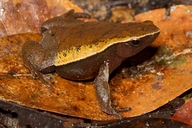|
Otophryne pyburni Campbell & Clarke, 1998
Pyburn's Pancake Frog | family: Microhylidae subfamily: Otophryninae genus: Otophryne |
 © 2014 Jean-Pierre Vacher (1 of 3) |
|
|
|
Description The dorsum can be reddish brown to grayish yellow or gray-brown and may be uniform in color, or patterned with darker streaks and a dark mid-dorsal stripe (Wassersug and Pyburn, 1987; Campbell and Clarke, 1998). A pale irregular stripe runs from the snout across the canthus to the eye and the top of the tynpanum, continuing along the side of the body. Below the stripe, the side of the body is dark brown. The sides of the head and the lower parts of the limbs are also dark brown, while the upper parts of the limbs are lighter and the same color as the dorsum. The throat is generally dark brown with pale speckles, with the chest also speckled but somewhat lighter brown, and the abdomen a pale cream to orange color. Some females may have a pale throat, and females also usually have a broader lateral pale stripe. The lower surface of the hindlimbs and feet are orange. Generally there are raised, cream-colored bumps present on the dorsum and the limbs (Campbell and Clarke, 1998). This frog blends well into leaf litter, having been described as resembling a "pinnately veined dead leaf" (Wassersug and Pyburn, 1987). It is capable of metachrosis, with reddish individuals able to become brown to grayish brown, and yellow individuals changing to yellow-gray (Wassersug and Pyburn, 1987). Distribution and Habitat Country distribution from AmphibiaWeb's database: Brazil, Colombia, French Guiana, Guyana, Suriname, Venezuela
Life History, Abundance, Activity, and Special Behaviors The tadpoles have two characteristics unique among microhylids. First, both the upper and lower jaws have a row of sharp, keratinized teeth. The toothed jaws might be used for predation (Pyburn, 1980)or possibly for filtering out sand, since the larvae live shallowly buried in the sand and filter-feed in shallow, clear streams (Wassersug and Pyburn, 1987). Second, the spiracle has an unusual location; it opens near the base of the tail, on the left posterior side of the ventrum, rather than midventrally. The spiracle extends as a tube as the tadpole grows, eventually reaching halfway down the tail (Zweifel, 2003). Trends and Threats Relation to Humans Comments
References
Campbell, J. A., and Clarke, B. T. (1998). ''A review of frogs of the genus Otophryne with the description of a new species.'' Herpetologica, 54(3), 301-317. IUCN, Conservation International, and NatureServe. 2006. Global Amphibian Assessment. www.globalamphibians.org. Accessed on 28 August 2007. Lescure, J. G., Grenand, F., and Grenand, P. (1980). ''Les amphibiens dans l'univers Wayapi.'' Journal d'Agriculture Traditionnelle et de Botanique Appliquée, 27, 247-261. Pyburn, W. F. (1980). ''An unusual anuran larva from the Vaupés region of southeastern Colombia.'' Papéis Avulsos de Zoologia (São Paulo), 33, 231-238. Zweifel, R. G. (2003). ''Pyburn's pancake frog, Otophryne pyburni.'' Grzimek's Animal Life Encyclopedia, Volume 6, Amphibians. 2nd edition. M. Hutchins, W. E. Duellman, and N. Schlager, eds., Gale Group, Farmington Hills, Michigan. Originally submitted by: Peera Chantasirivisal (first posted 2005-11-09) Edited by: Kellie Whittaker (2008-01-03) Species Account Citation: AmphibiaWeb 2008 Otophryne pyburni: Pyburn's Pancake Frog <https://amphibiaweb.org/species/5483> University of California, Berkeley, CA, USA. Accessed May 21, 2025.
Feedback or comments about this page.
Citation: AmphibiaWeb. 2025. <https://amphibiaweb.org> University of California, Berkeley, CA, USA. Accessed 21 May 2025. AmphibiaWeb's policy on data use. |


 Map of Life
Map of Life